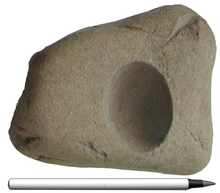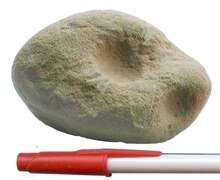Omarolluk: Difference between revisions
Removed unrelated figures and links to artifacts as Omarolluk are natural features - they are not artifacts |
|||
| Line 8: | Line 8: | ||
|caption = An Omar with a hemispherical void in its side. |
|caption = An Omar with a hemispherical void in its side. |
||
}} |
}} |
||
[[File:NutterPen759.pdf|right|thumb|[[cupstone]]]] |
|||
'''Omarolluks''', sometimes shortened to "omars," are a distinctive type of [[glacial erratic]] that consists of dark siliceous [[greywacke]] and exhibits prominent rounded, often deep, hemispherical voids and pits. The hemispherical voids and pits result from the selective dissolution of carbonate [[concretion]]s within the greywacke. The greywacke, of which Omars consist, is identifiable by its low metamorphic grade and the 10%–40% rock fragments, distinctive volcanic clasts, and spherical carbonate concretions that it contains. Omars are typically rounded and range in size from pebbles to boulders. Their rounded shape, whether found in [[Till|glacial tills]] or glacial-fluvial (outwash) gravels, indicate that they were eroded from pre-existing [[Littoral zone|littoral]] or [[fluvial]] deposits. Omars are typically found associated with [[Granule (geology)|granule]]s and [[pebble]]s of [[Oolite|oolitic]] [[jasper]] that were transported from the [[Belcher Islands]] in [[Hudson Bay]], [[Canada]].<ref name="DonaldsonOthers1997a">Donaldson, A. and V.K. Prest (1997) ''Criteria for recognizing omars, widely dispersed indicators of Pleistocene history in North America.'' GAC/MAC Abs. 22:40, Ottawa.</ref><ref name="PrestOthers2000a">Prest, V.K., J.A. Donaldson, and H.D. Mooers (2000) ''The omar story: the role of omars in assessing glacial history of west-central North America.'' Géographie Physique et Quaternaire 54(3):257-270.</ref><ref name="MooersOthers1998a">Mooers, H.D., and J.D. Lehr (1998) ''Terrestrial record of Laurentide Ice Sheet reorganization during Heinrich events: Reply.'' Geology. 26(7):668-669.</ref> |
'''Omarolluks''', sometimes shortened to "omars," are a distinctive type of [[glacial erratic]] that consists of dark siliceous [[greywacke]] and exhibits prominent rounded, often deep, hemispherical voids and pits. The hemispherical voids and pits result from the selective dissolution of carbonate [[concretion]]s within the greywacke. The greywacke, of which Omars consist, is identifiable by its low metamorphic grade and the 10%–40% rock fragments, distinctive volcanic clasts, and spherical carbonate concretions that it contains. Omars are typically rounded and range in size from pebbles to boulders. Their rounded shape, whether found in [[Till|glacial tills]] or glacial-fluvial (outwash) gravels, indicate that they were eroded from pre-existing [[Littoral zone|littoral]] or [[fluvial]] deposits. Omars are typically found associated with [[Granule (geology)|granule]]s and [[pebble]]s of [[Oolite|oolitic]] [[jasper]] that were transported from the [[Belcher Islands]] in [[Hudson Bay]], [[Canada]].<ref name="DonaldsonOthers1997a">Donaldson, A. and V.K. Prest (1997) ''Criteria for recognizing omars, widely dispersed indicators of Pleistocene history in North America.'' GAC/MAC Abs. 22:40, Ottawa.</ref><ref name="PrestOthers2000a">Prest, V.K., J.A. Donaldson, and H.D. Mooers (2000) ''The omar story: the role of omars in assessing glacial history of west-central North America.'' Géographie Physique et Quaternaire 54(3):257-270.</ref><ref name="MooersOthers1998a">Mooers, H.D., and J.D. Lehr (1998) ''Terrestrial record of Laurentide Ice Sheet reorganization during Heinrich events: Reply.'' Geology. 26(7):668-669.</ref> |
||
The name given these glacial erratics refer to their source, which is the [[Proterozoic]] Omarolluk Formation in the Belcher Islands in southeast Hudson Bay. The Laurentide Ice Sheet eroded omars from the Belcher Islands, an [[archipelago]] limited to only about a quarter of 1% of Hudson Bay. [[Glaciers]] moved omars from the southeastern part of Hudson Bay to central Canada and into the U.S. where they were deposited on [[moraines]]. Because scientists know precisely where they came from they are very valuable in documenting the movement of glaciers.<ref name="PrestOthers2000a"/><ref name="Dutchnda">Dutch, S. (n.d.) [http://www.uwgb.edu/dutchs/Petrology/Leaverite-SedFeat.HTM ''Leaverites - Features in Sedimentary Rocks.''] Natural and Applied Sciences, University of Wisconsin, Green Bay, Wisconsin Downloaded October 28, 2009</ref><ref name="Wilson2007a">Wilson, G. (2007) [http://www.turnstone.ca/rom74om.htm ''An omar (siltstone erratic).''] Turnstone Geological Services Ltd, Campbellford, Ontario, Canada. Downloaded October 28, 2009</ref> |
The name given these glacial erratics refer to their source, which is the [[Proterozoic]] Omarolluk Formation in the Belcher Islands in southeast Hudson Bay. The Laurentide Ice Sheet eroded omars from the Belcher Islands, an [[archipelago]] limited to only about a quarter of 1% of Hudson Bay. [[Glaciers]] moved omars from the southeastern part of Hudson Bay to central Canada and into the U.S. where they were deposited on [[moraines]]. Because scientists know precisely where they came from they are very valuable in documenting the movement of glaciers.<ref name="PrestOthers2000a"/><ref name="Dutchnda">Dutch, S. (n.d.) [http://www.uwgb.edu/dutchs/Petrology/Leaverite-SedFeat.HTM ''Leaverites - Features in Sedimentary Rocks.''] Natural and Applied Sciences, University of Wisconsin, Green Bay, Wisconsin Downloaded October 28, 2009</ref><ref name="Wilson2007a">Wilson, G. (2007) [http://www.turnstone.ca/rom74om.htm ''An omar (siltstone erratic).''] Turnstone Geological Services Ltd, Campbellford, Ontario, Canada. Downloaded October 28, 2009</ref> |
||
== See also == |
|||
* [[Cupstone]] |
|||
* [[Lithic technology]] |
|||
==References== |
==References== |
||
<references/> |
<references/> |
||
{{Prehistoric technology}} |
|||
[[Category:Sedimentology]] |
[[Category:Sedimentology]] |
||
Revision as of 04:04, 11 March 2014
| Omar | |
|---|---|
 An Omar with a hemispherical void in its side. | |
| General | |
| Category | Native Minerals |

Omarolluks, sometimes shortened to "omars," are a distinctive type of glacial erratic that consists of dark siliceous greywacke and exhibits prominent rounded, often deep, hemispherical voids and pits. The hemispherical voids and pits result from the selective dissolution of carbonate concretions within the greywacke. The greywacke, of which Omars consist, is identifiable by its low metamorphic grade and the 10%–40% rock fragments, distinctive volcanic clasts, and spherical carbonate concretions that it contains. Omars are typically rounded and range in size from pebbles to boulders. Their rounded shape, whether found in glacial tills or glacial-fluvial (outwash) gravels, indicate that they were eroded from pre-existing littoral or fluvial deposits. Omars are typically found associated with granules and pebbles of oolitic jasper that were transported from the Belcher Islands in Hudson Bay, Canada.[1][2][3]
The name given these glacial erratics refer to their source, which is the Proterozoic Omarolluk Formation in the Belcher Islands in southeast Hudson Bay. The Laurentide Ice Sheet eroded omars from the Belcher Islands, an archipelago limited to only about a quarter of 1% of Hudson Bay. Glaciers moved omars from the southeastern part of Hudson Bay to central Canada and into the U.S. where they were deposited on moraines. Because scientists know precisely where they came from they are very valuable in documenting the movement of glaciers.[2][4][5]
See also
References
- ^ Donaldson, A. and V.K. Prest (1997) Criteria for recognizing omars, widely dispersed indicators of Pleistocene history in North America. GAC/MAC Abs. 22:40, Ottawa.
- ^ a b Prest, V.K., J.A. Donaldson, and H.D. Mooers (2000) The omar story: the role of omars in assessing glacial history of west-central North America. Géographie Physique et Quaternaire 54(3):257-270.
- ^ Mooers, H.D., and J.D. Lehr (1998) Terrestrial record of Laurentide Ice Sheet reorganization during Heinrich events: Reply. Geology. 26(7):668-669.
- ^ Dutch, S. (n.d.) Leaverites - Features in Sedimentary Rocks. Natural and Applied Sciences, University of Wisconsin, Green Bay, Wisconsin Downloaded October 28, 2009
- ^ Wilson, G. (2007) An omar (siltstone erratic). Turnstone Geological Services Ltd, Campbellford, Ontario, Canada. Downloaded October 28, 2009
